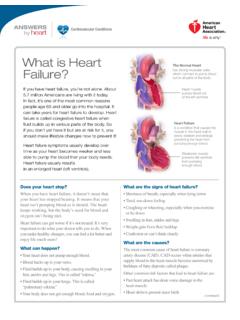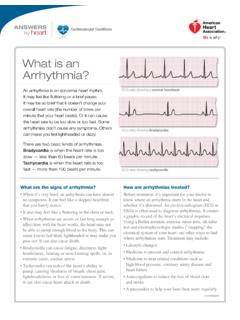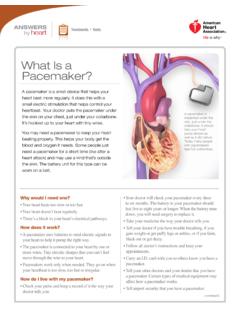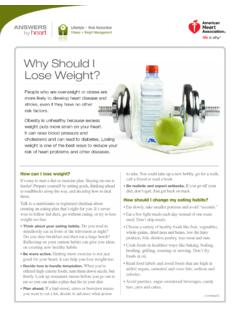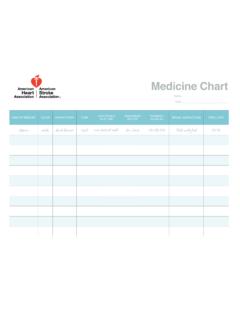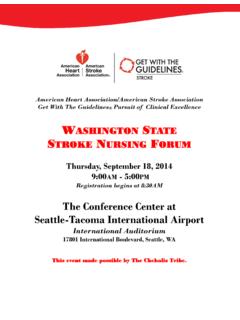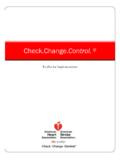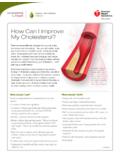Transcription of PREVENTION OF INFECTIVE ENDOCARDITIS - heart.org
1 PREVENTION OF INFECTIVE ENDOCARDITISThis wallet card is to be given to patients (or parents) by their health care professional. Please see back of card for reference to the complete : Needs protection from INFECTIVE ENDOCARDITIS because of an existing heart : Prescribed by: Date: You received this wallet card because you are at increased risk for developing adverse outcomes from INFECTIVE ENDOCARDITIS (IE). The recommendations for PREVENTION of IE shown in this card are based on the most current of the American College of Cardiology/American Heart Association Joint Committee on Clinical Practice Guidelines and the American Heart Association s Rheumatic Fever, ENDOCARDITIS , and Kawasaki Disease Committee, together with national and international experts on IE, extensively reviewed published studies in order to determine whether dental, gastrointestinal (GI) or genitourinary (GU) tract procedures are possible causes of IE.
2 Findings from these studies showed no conclusive evidence linking GI or GU tract procedures with the development of IE. They also concluded that antibiotics before dental procedures are reasonable only for certain patients at increased risk of developing IE and at highest risk of poor outcomes from practice of routinely giving antibiotics to patients at risk for IE prior to dental procedures is not recommended EXCEPT for patients with the highest risk of adverse outcomes resulting from IE (see below on this card). The Committees concluded that only a small number of IE cases might be prevented by antibiotic prophylaxis prior to a dental procedure. In addition, prophylaxis should be reserved ONLY for patients with cardiac conditions associated with the highest risk that are listed below. You can reduce the risk of IE by maintaining good oral health through regular professional dental care and the use of dental products, such as manual, powered and ultrasonic toothbrushes; dental floss; and other plaque-removal guidance does not change the fact that your cardiac condition may put you at increased risk for developing IE.
3 If you develop signs or symptoms of IE such as unexplained fever see your doctor right away. If blood cultures are necessary (to determine if ENDOCARDITIS is present), it is important for your doctor to obtain these cultures and other relevant tests BEFORE antibiotics are prophylaxis is reasonable before dental procedures that involve manipulation of the gingival tissue, manipulation of the periapical region of teeth, or perforation of the oral mucosa in patients with valvular heart disease who have any of the following: Prosthetic cardiac valves, including transcatheter-implanted prostheses and homografts Prosthetic material used for cardiac valve repair, such as annuloplasty rings, chords or clips Previous IE Unrepaired cyanotic congenital heart defect (CHD) or repaired CHD, with residual shunts or valvular regurgitation at the site of or adjacent to the site of a prosthetic patch or prosthetic device* Cardiac transplant with valve regurgitation due to a structurally abnormal valve* Except for the conditions listed above, antibiotic prophylaxis before dental procedures is not recommended for any other types of prophylaxis is NOT recommended for the following dental procedures or events: routine anesthetic injections through noninfected tissue; taking dental radiographs; placement of removable prosthodontic or orthodontic appliances; adjustment of orthodontic appliances.
4 Placement of orthodontic brackets; and shedding of deciduous teeth and bleeding from trauma to the lips or oral mucosa. Copyright 2021 American Heart Association, Inc., a 501(c)(3) not-for-profit. All rights reserved. Unauthorized use prohibited. 50-1605 2112 National Center7272 Greenville AvenueDallas, Texa s ChildrenOralAmoxicillin2 g50 mg/kgUnable to take oral medicationAmpicillin OR2 g IM or IV50 mg/kg IM or IVCefazolin or ceftriaxone1 g IM or IV50 mg/kg IM or IVAllergic to penicillins or ampicillin oral regimenCephalexin* 2 g50 mg/kgORAzithromycin or clarithromycin500 mg15 mg/kgORDoxycycline100 mg<45 kg, mg/kg>45 kg, 100 mgAllergic to penicillin or ampicillin and unable to take oral medicationCefazolin or ceftriaxone 1 g IM or IV50 mg/kg IM or IVClindamycin is no longer recommended for antibiotic prophylaxis for a dental indicates intramuscular; and IV, intravenous.
5 * Or other first- or second-generation oral cephalosporin in equivalent adult or pediatric dosing. Cephalosporins should not be used in an individual with a history of anaphylaxis, angioedema, or urticaria with penicillin or Procedures: In patients with valvular heart disease who are at high risk of IE, antibiotic prophylaxis is not recommended for nondental procedures ( , TEE, esophagogastroduodenoscopy, colonoscopy or cystoscopy) in the absence of active Procedures: Prophylaxis for procedures involving the respiratory tract, infected skin and skin structures, tissues just under the skin or musculoskeletal tissue is discussed in the documents referenced below. PREVENTION of Viridans Group Streptococcal INFECTIVE ENDOCARDITIS : A Scientific Statement From the American Heart Association. Circulation. 2021;143:e e . Accessible at ACC/AHA Guideline for the Management of Patients With Valvular Heart Disease: A Report of the American College of Cardiology/American Heart Association Joint Committee on Clinical Practice Guidelines.
6 Circulation. 2021;143:e72-e227. Accessible at Health care professionals Please refer to the above guidance for additional information regarding the use of antibiotic prophylaxis to reduce risk of INFECTIVE procedures for which prophylaxis is reasonable in patients with cardiac conditions are listed on reverse Prophylactic Regimens for Dental ProceduresRegimen Single dose 30 to 60 minutes before procedur
